24 Minimalist Japandi Garden Ideas for a Sophisticated Sanctuary
Japandi garden design merges the clean, functional lines of Scandinavian minimalism with the natural harmony and traditional elements of Japanese landscaping. This style focuses on simplicity, balance, and the intentional use of natural materials to create peaceful, uncluttered outdoor spaces.
The approach often combines features like raked sand beds, stepping stone paths, bonsai trees, koi ponds, and wooden structures, emphasizing both beauty and utility.
By blending muted color palettes, organic textures, and open layouts, Japandi gardens offer areas for quiet reflection, gentle movement, and connection with nature.
The 24 ideas presented here provide practical inspiration for creating minimalist outdoor spaces that feel serene, functional, and visually cohesive, whether you have a spacious yard or a compact courtyard.
1. A Serene Minimalist Japandi Zen Garden Corner
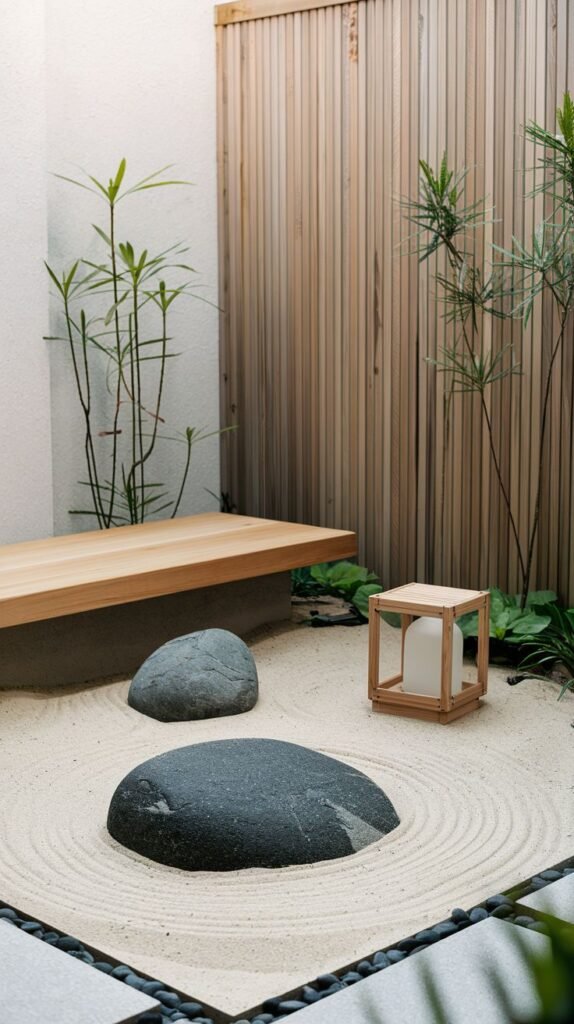
Cultivate a corner of calm in your outdoor space by designing a minimalist Japandi garden featuring a raked sand bed. Incorporate several large, smooth river stones as focal points, allowing their natural forms to ground the design. Position a simple, light-toned wooden bench along a vertically slatted wooden wall, providing a clean backdrop and a quiet spot for contemplation. Add a subtle wooden lantern with a soft glow to enhance the peaceful ambiance, especially during evening hours. Introduce a few tall, slender plants in the background to provide height and a touch of natural green without overwhelming the simplicity of the sand and stone arrangement.
2. Tranquil Courtyard Japandi Garden with Central Bonsai
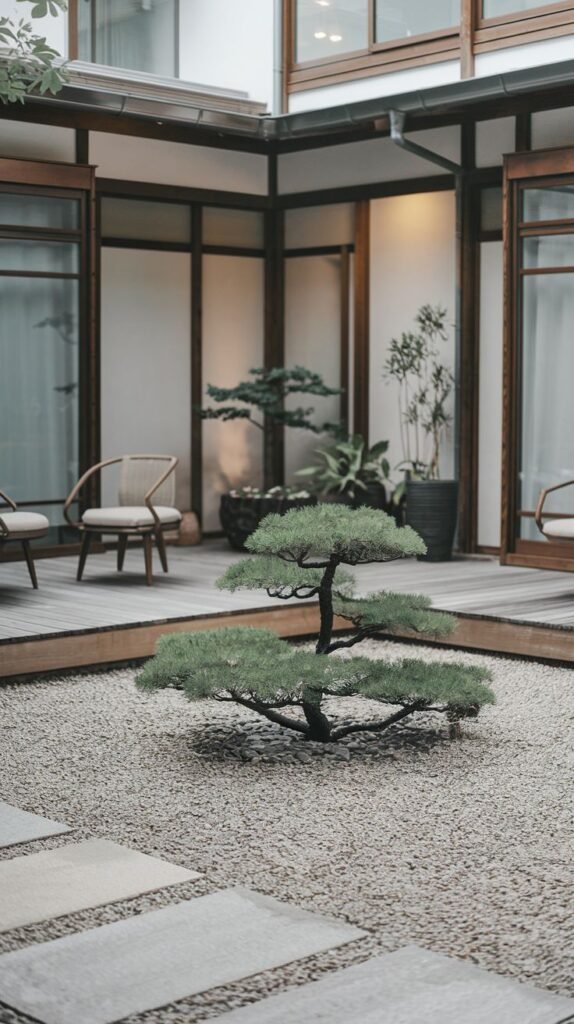
Design an inner courtyard as a serene Japandi garden sanctuary, utilizing an open layout that seamlessly connects indoor and outdoor spaces. Place a single, meticulously sculpted bonsai tree as the central anchor of the garden, drawing the eye and embodying timeless artistry. Cover the ground with uniform light-colored gravel, creating a clean, understated base that highlights the plant life. Install a spacious wooden deck around the perimeter, providing ample room for movement and the placement of simple, comfortable outdoor seating. Ensure large sliding glass doors or open frames allow natural light and views into the garden from adjacent rooms, fostering a continuous flow between inside and out.
3. Minimalist Outdoor Deck with Reflective Pond
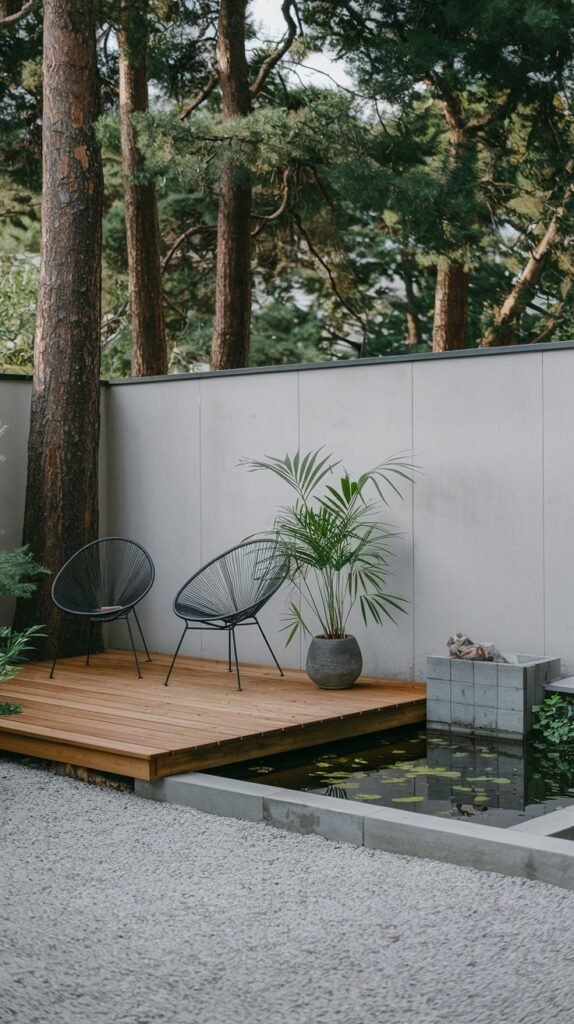
Create an inviting outdoor living area with a minimalist wooden deck that features a carefully integrated water element. Construct a rectangular pond flush with the decking, allowing its dark, reflective surface to add depth and tranquility to the space. Introduce a few water lilies or subtle aquatic plants to bring life to the pond without cluttering its surface. Arrange a pair of contemporary, open-weave chairs on the deck, offering comfortable seating that complements the modern aesthetic. Position a potted palm or similar simple greenery nearby to soften the architectural lines and add a touch of natural lushness.
4. Enchanting Stepping Stone Path in a Japandi Landscape
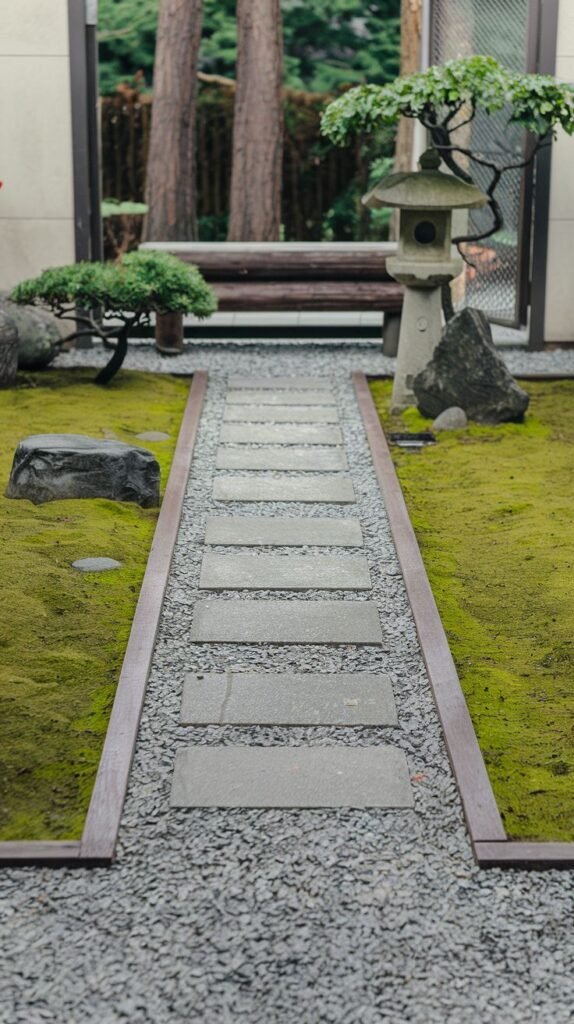
Develop a captivating pathway through your Japandi garden by laying rectangular stepping stones amidst a verdant carpet of moss. Frame the stone path with a border of small, dark gravel, creating a crisp contrast and defining the walkway. Incorporate traditional Japanese garden elements such as a stone lantern and a small, artfully pruned tree to evoke a sense of heritage and tranquility. Allow the vibrant green moss to spread naturally around the stones, creating a soft, organic texture underfoot and visually connecting the elements of the landscape.
5. Textured Minimalist Garden with Bold Rock Features
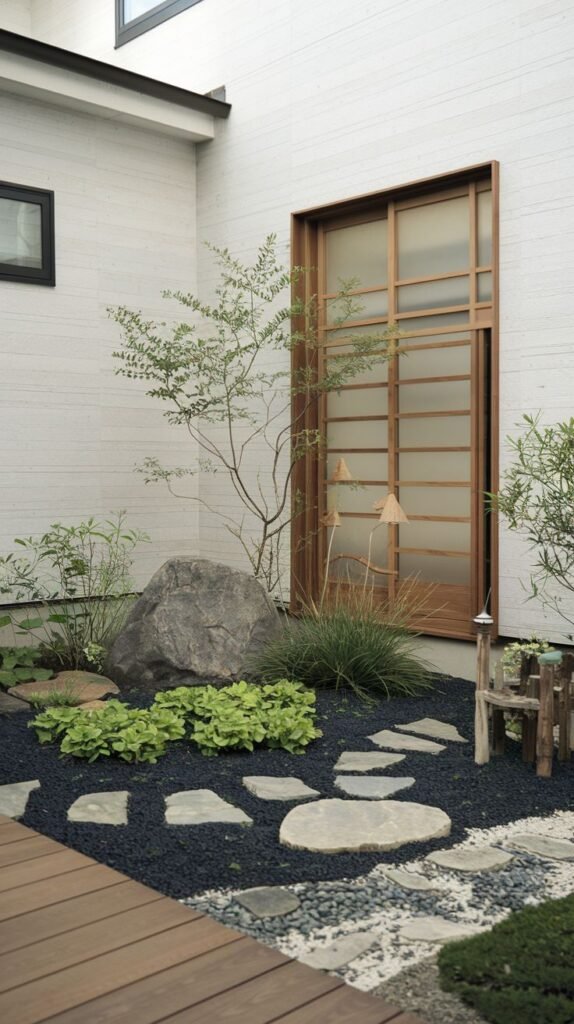
Construct a striking minimalist garden by utilizing contrasting textures and bold natural elements. Lay dark, almost black, gravel across the majority of the ground plane, providing a dramatic backdrop for lighter elements. Place large, irregular stepping stones of varying shapes and sizes across the dark gravel, inviting exploration and visual interest. Anchor the composition with a substantial, naturally weathered boulder, allowing its scale and form to become a key focal point. Introduce patches of vibrant green groundcover and taller, slender plants to soften the hardscape and introduce organic forms, creating a balanced and visually engaging space.
6. A Calming Gravel Path with Organic Stepping Stones
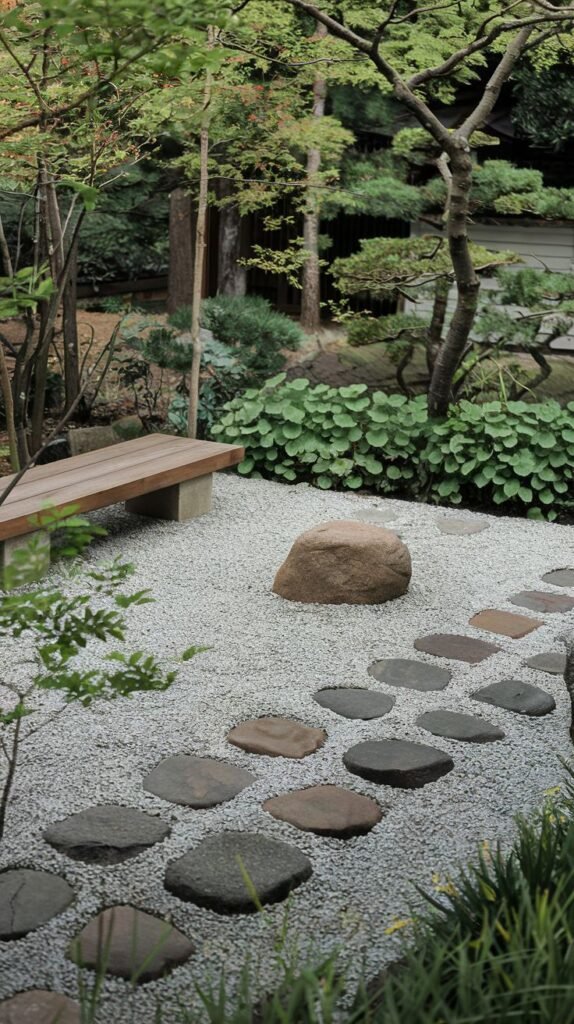
Design a serene Japandi garden path using light-colored gravel as the primary ground cover, offering a bright and expansive feel. Arrange a series of naturally shaped, flat stepping stones in a meandering pattern through the gravel, guiding the eye and encouraging leisurely strolls. Position a simple, elongated wooden bench along the path’s edge, inviting moments of rest and contemplation amidst the natural surroundings. Surround the path with lush, varied green foliage and taller trees in the background, ensuring the garden feels integrated with its environment while maintaining a sense of quiet solitude.
7. Picturesque Koi Pond in a Japandi Garden Setting
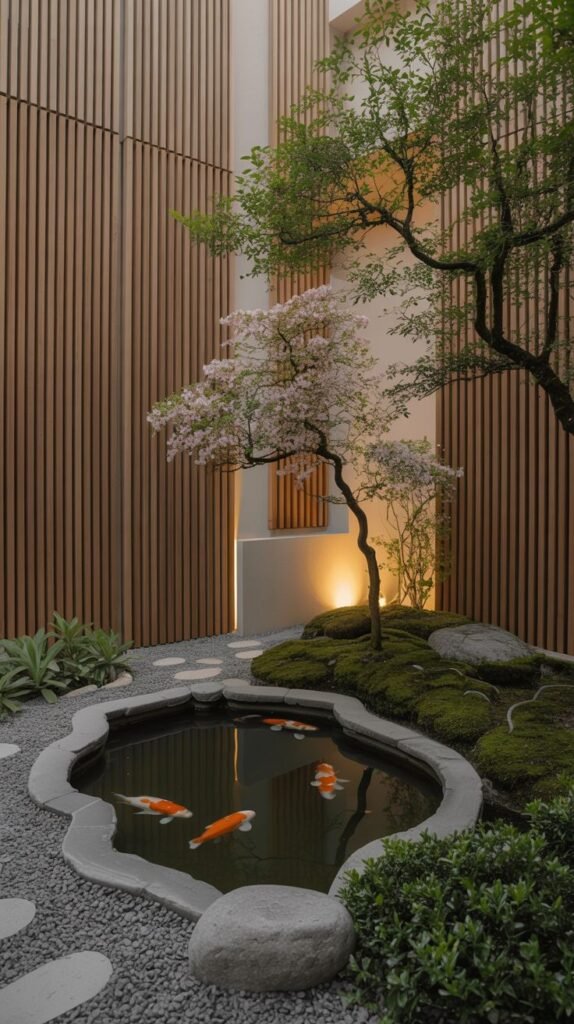
Create a captivating water feature as the heart of your Japandi garden by installing a uniquely shaped koi pond. Ensure the pond is deep enough to support healthy koi, and integrate large, smooth rocks around its edges to blend seamlessly with the natural environment. Cultivate lush moss around the pond’s perimeter, adding a soft, ancient feel to the landscape. Plant a delicate flowering tree, such as a cherry blossom, near the pond, allowing its branches to gracefully arch over the water and its blooms to add seasonal beauty. Incorporate vertical wooden slat walls and subtle lighting to provide privacy and illuminate the space during the evening.
8. Sculptural Japandi Garden with Natural Elements
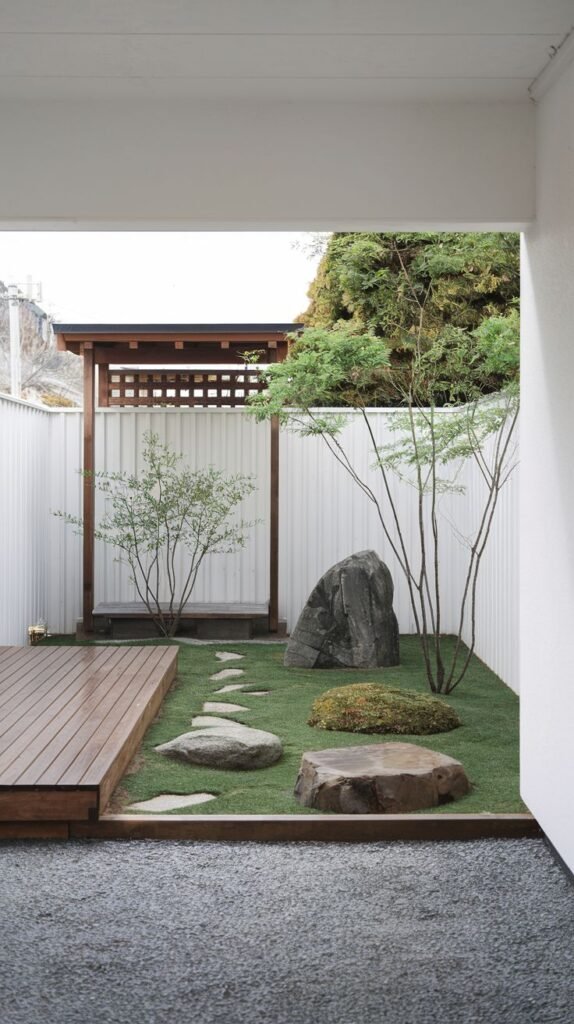
Design an open and inviting Japandi garden space focusing on sculptural natural elements and broad, clear areas. Establish a smooth, expansive lawn as the main ground cover, offering a clean and uncluttered visual foundation. Strategically place several large, distinct natural boulders of varying sizes and shapes across the lawn, acting as natural sculptures and focal points. Integrate a raised wooden deck into the garden, providing a clean architectural platform and a transition space. Include a small, artfully designed wooden shelter or structure in the background, adding a traditional touch and visual interest.
9. Urban Minimalist Garden with Vertical Green Wall and Water Feature
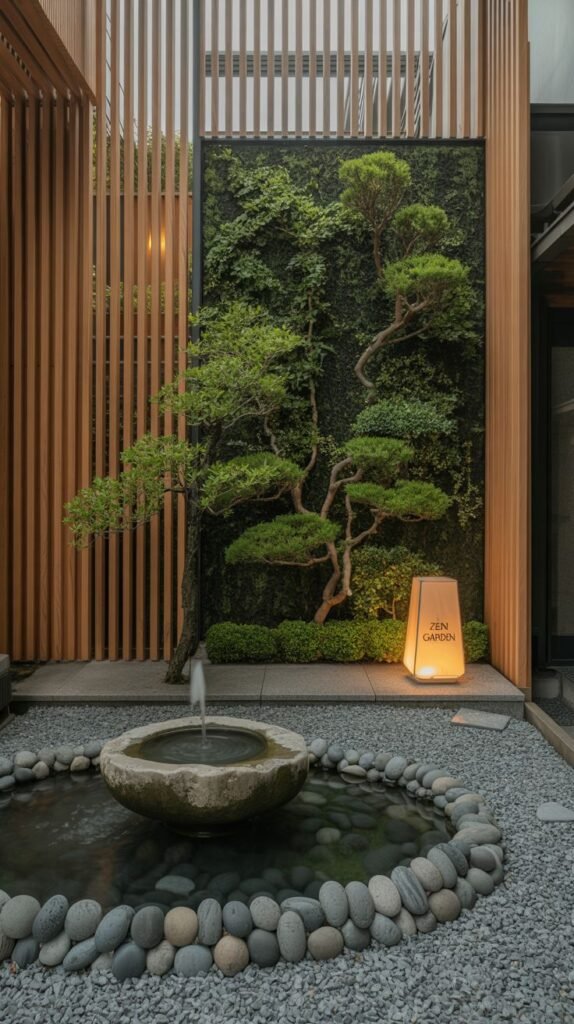
Transform an urban space into a vibrant minimalist garden by incorporating a striking vertical green wall. Design the green wall with artfully shaped and trained trees or climbing plants, turning a flat surface into a living tapestry. Implement a stone fountain with a gentle water spouting into a pebble-lined circular pool, creating a soothing auditory element. Flank the vertical garden and water feature with vertical wooden slats, providing both structure and a natural aesthetic. Place a subtle outdoor lantern to reinforce the meditative and calming purpose of the space.
10. Contemplative Japandi Garden with Natural Stone Water Spout
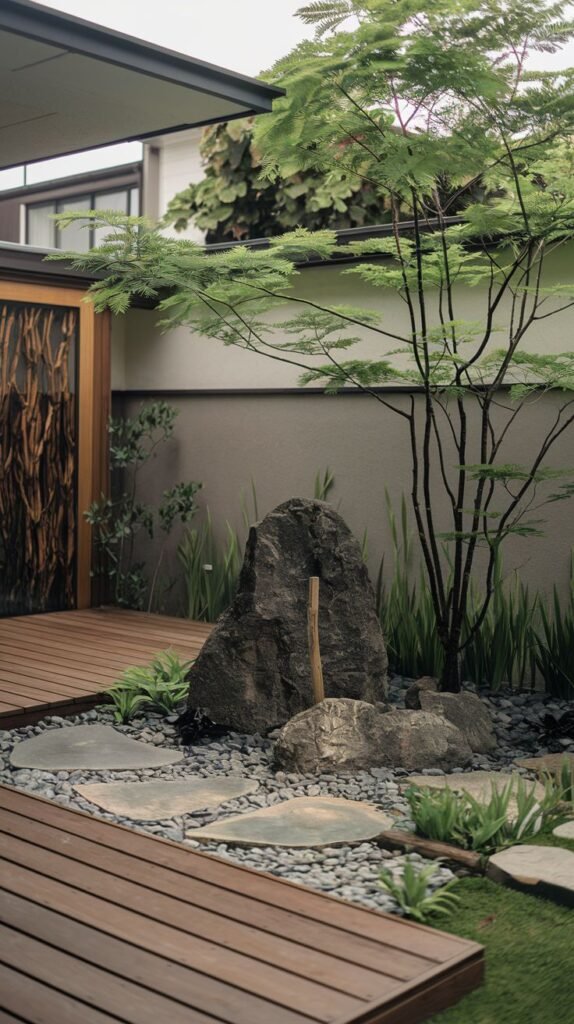
Develop a serene and contemplative Japandi garden featuring a natural stone water element as its centerpiece. Select a large, dark, rugged boulder and integrate a subtle bamboo water spout, allowing water to gently trickle over the stone and into a basin below. Surround the water feature with small, dark pebbles and lush, spiky greenery, creating a textural contrast. Lay a series of flat, irregular stepping stones across the garden floor, guiding visitors through the space. Incorporate a wide, low wooden deck that extends into the garden, providing a comfortable platform for viewing and relaxation.
11. Enchanting Moss Garden with a Delicate Cherry Blossom
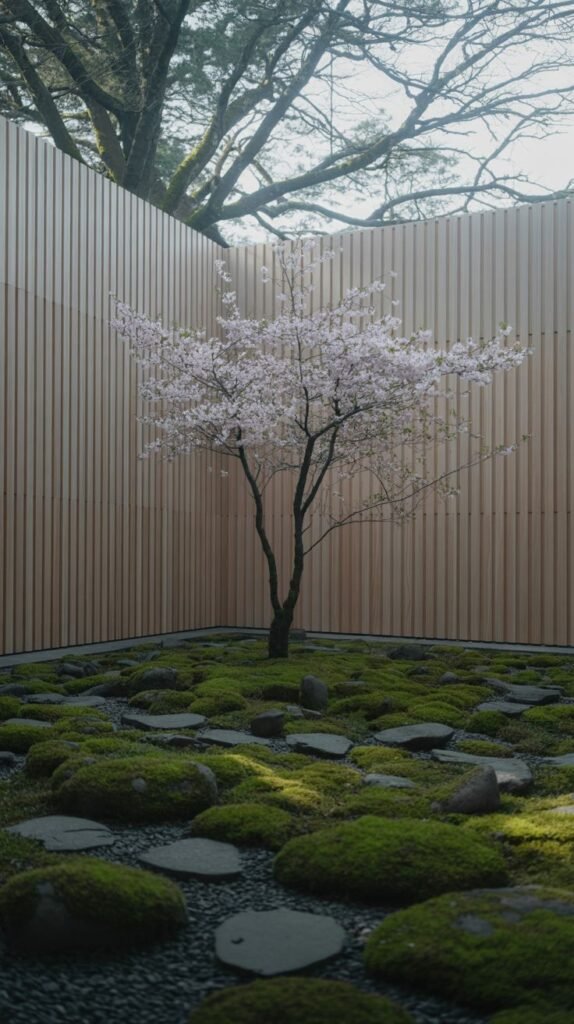
Craft a truly enchanting minimalist garden by cultivating an extensive ground cover of vibrant green moss. Intersperse the moss with strategically placed dark, irregular stepping stones, inviting gentle exploration of the space. Plant a single, elegant cherry blossom tree at the heart of the moss garden, allowing its delicate branches and soft pink blooms to become the focal point. Enclose the garden with tall, uniform wooden slat walls, creating a secluded and immersive natural environment that emphasizes the beauty of the flowering tree and the lush moss.
12. Architectural Japandi Corner Garden with Bold Stone Elements
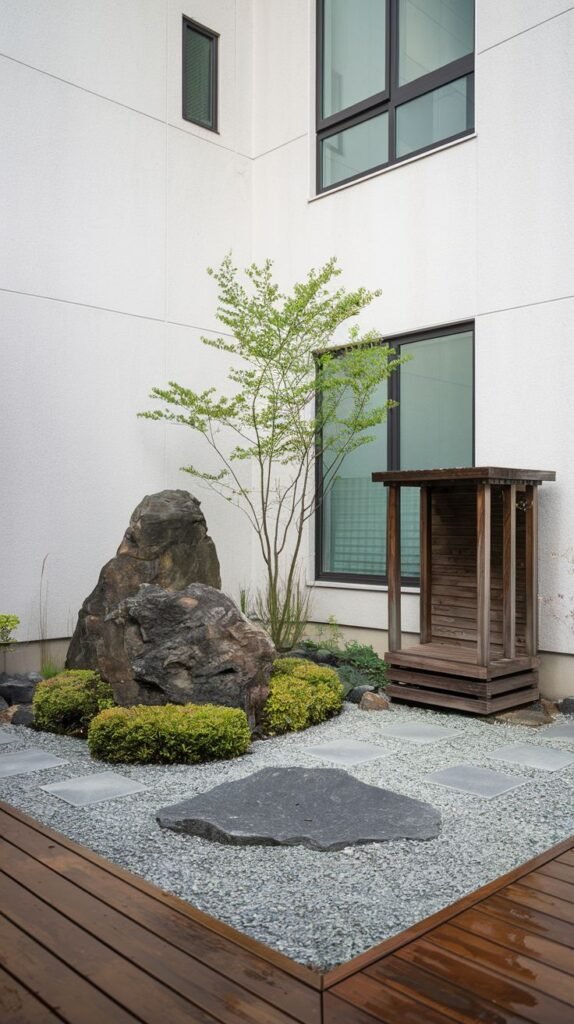
Design an architectural yet natural Japandi garden in a corner space, utilizing bold stone elements against clean building lines. Place several large, imposing natural rocks as prominent sculptural features, contrasting their organic forms with the minimalist white walls of the building. Cover the ground with light-colored gravel, providing a clean and understated base. Introduce a large, flat, irregularly shaped stepping stone as a central anchor, offering a sturdy surface. Incorporate a small, neatly designed wooden shelter or structure, adding a touch of traditional craftsmanship to the contemporary setting.
13. Intimate Minimalist Garden Along a Building Façade
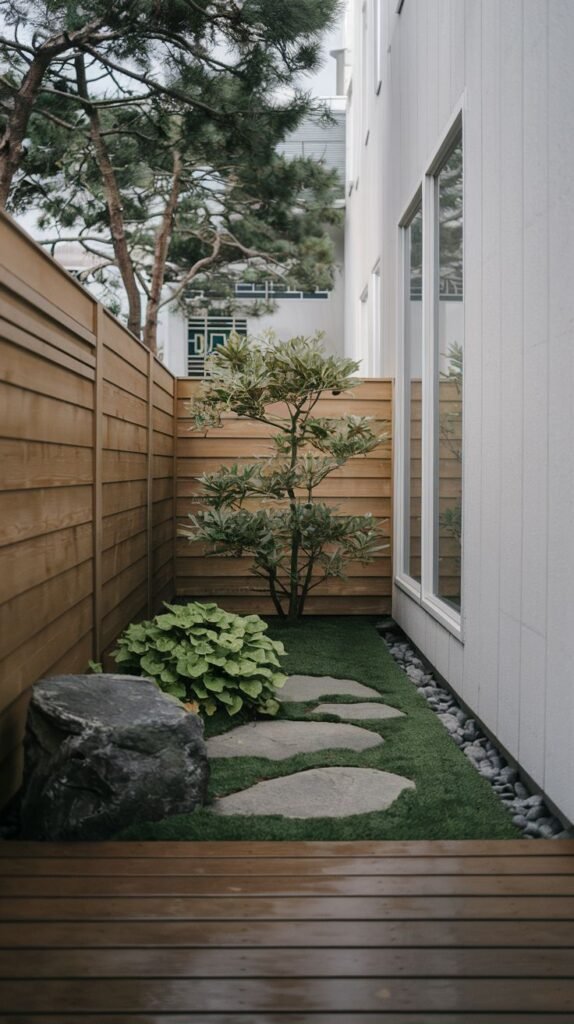
Create a private and intimate minimalist garden in a narrow side yard or along a building facade. Lay a path of irregular stepping stones over a soft green turf or groundcover, guiding the eye through the compact space. Position a large, solid natural boulder as a grounding element near the pathway. Plant a small, artfully pruned tree and a few lush, broad-leafed plants to add varied textures and greenery. Install a tall wooden privacy fence along one side to create a secluded feel, while allowing the building wall to serve as a clean backdrop.
14. Serene Passageway Japandi Garden with Flowering Tree
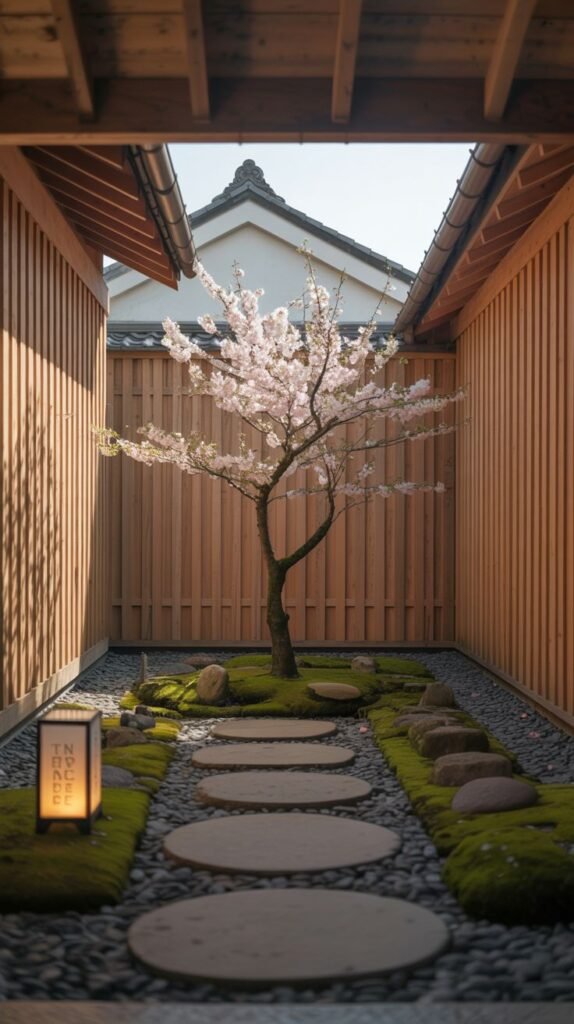
Transform a narrow passageway into a captivating Japandi garden experience, using carefully selected elements to create depth and beauty. Define the path with a border of dark pebbles and lush moss, leading the eye forward. Lay a series of oval stepping stones in a linear fashion, providing a clear and inviting walkway. Plant a central flowering tree, such as a cherry blossom, allowing its delicate blooms to soften the enclosed space. Frame the passageway with tall wooden slat walls, creating a sense of enclosure and privacy, and add a decorative lantern for subtle lighting and charm.
15. Meandering Minimalist Garden Path with Integrated Seating
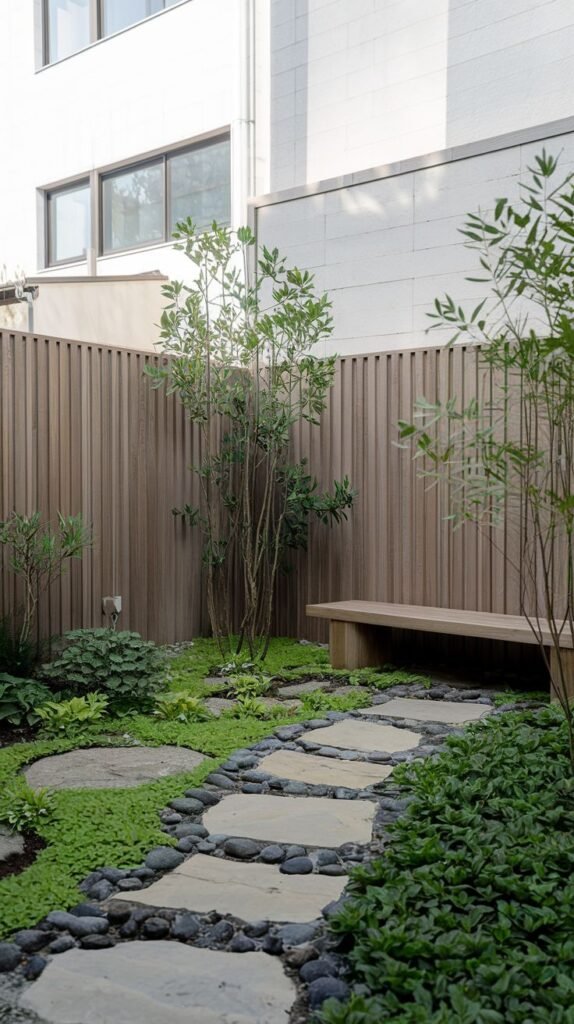
Design a dynamic yet serene minimalist garden path that gracefully meanders through various green textures. Lay irregular stepping stones to form a winding path, encouraging a leisurely pace through the landscape. Surround the path with a mix of small dark pebbles and diverse groundcovers, creating rich textural contrasts and visual interest. Integrate a long, simple wooden bench into the design, positioned at a scenic point to invite rest and appreciation of the garden. Plant taller, slender trees and lush shrubs around the perimeter to create a sense of enclosure and privacy, making the garden feel like a secluded oasis.
16. Elevated Japandi Garden with Classic Zen Features
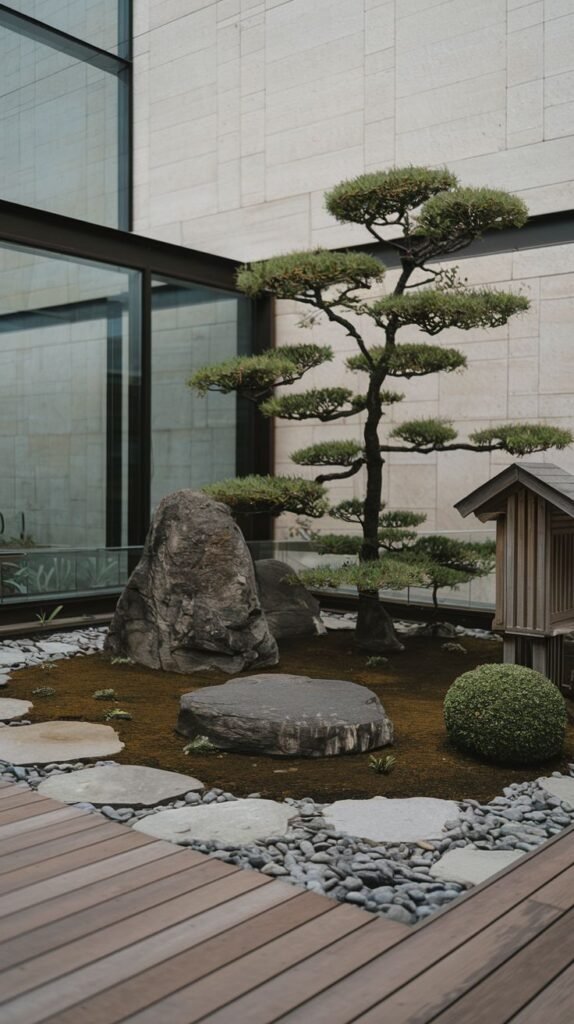
Construct an elevated Japandi garden that beautifully showcases classic Zen elements on a raised wooden deck. Feature a meticulously sculpted bonsai tree as a central masterpiece, embodying artistic control over nature. Arrange several natural rocks of varying sizes alongside the bonsai, grounding the composition. Include a perfectly manicured spherical bush to add a contrasting soft, geometric form. Surround these elements with a bed of raked gravel and patches of lush moss, simulating natural islands in a calm sea. Frame the entire installation with broad wooden decking, providing a clean viewing platform and a harmonious transition to the surrounding architecture.
17. Contemplative Minimalist Zen Garden with Raked Sand
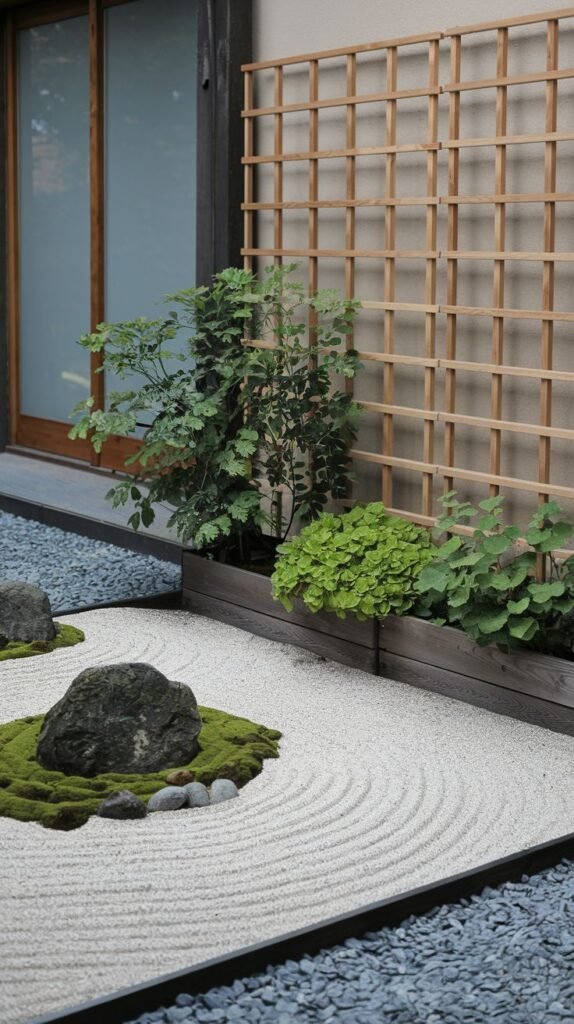
Create a space for contemplation with a minimalist Japandi garden featuring a large area of precisely raked white sand. Design intricate, circular patterns in the sand around a central moss-covered island, which hosts a significant natural rock. Border the raked sand with dark gravel to provide a clean, sharp edge and define the garden’s boundaries. Integrate wooden planters along the perimeter, filled with simple green plants that complement the tranquil aesthetic. Install a wooden lattice screen on the adjacent wall to add texture and provide a subtle backdrop without distracting from the main elements.
18. Grand Minimalist Japandi Zen Garden with Water Feature
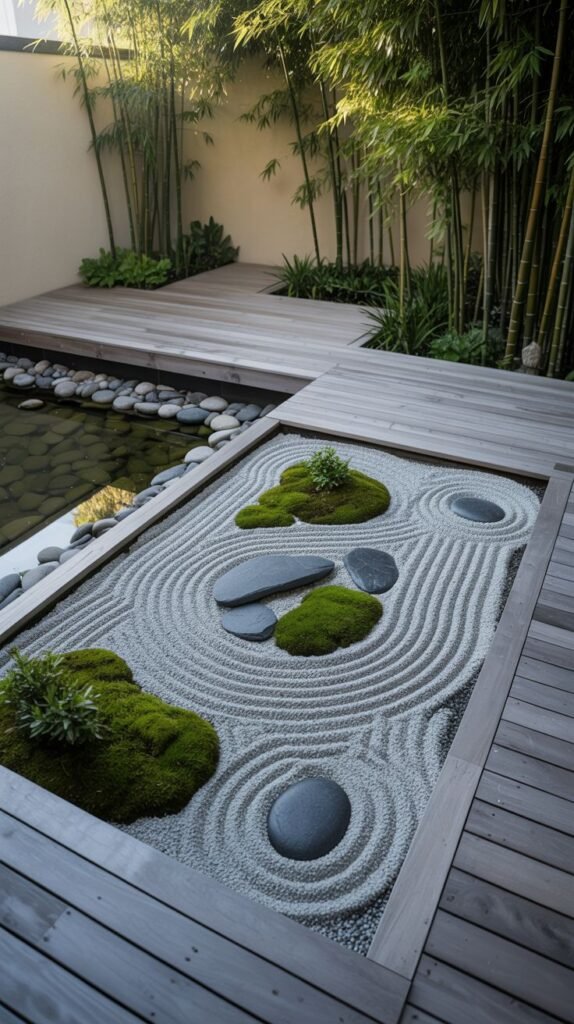
Develop an expansive and immersive minimalist Japandi garden that combines the classic dry landscape with a tranquil water element. Lay a large, rectangular bed of light-colored sand, meticulously raked into elegant, undulating patterns that evoke the movement of water. Incorporate several islands of vibrant green moss, adorned with various sizes of natural stones, suggesting mountains or islands in a vast ocean. Design a shallow, dark water feature alongside the dry garden, allowing its calm surface to reflect the surrounding elements. Frame the entire composition with extensive wooden decking, creating a seamless flow and multiple vantage points for enjoying the grand design.
19. Open Corner Japandi Garden with Prominent Bonsai and Stones
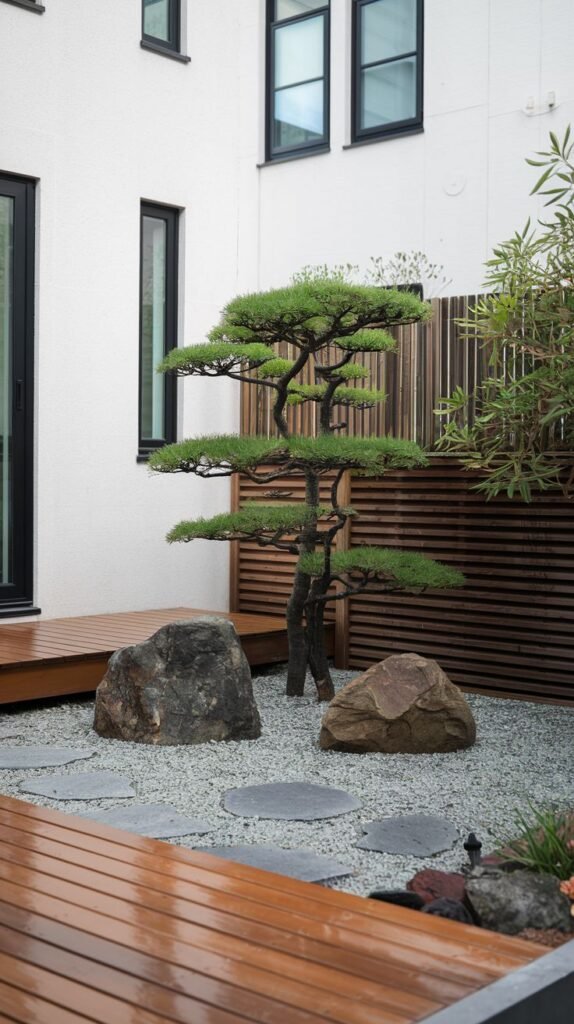
Utilize an open corner space to design a dynamic Japandi garden, highlighting strong natural forms. Position a prominent, artfully sculpted bonsai tree as a key focal point, its form bringing character and age to the scene. Arrange two or more substantial natural rocks of contrasting colors and textures around the base of the bonsai, anchoring the design. Cover the ground with light-colored gravel, providing a clean and unobtrusive backdrop. Integrate irregular flat stepping stones within the gravel, offering a path through the space. Frame the garden with a horizontal wooden slat fence and adjacent wooden decking, creating a cohesive and inviting environment.
20. Harmonious Minimalist Garden with a Reflective Sunken Pond
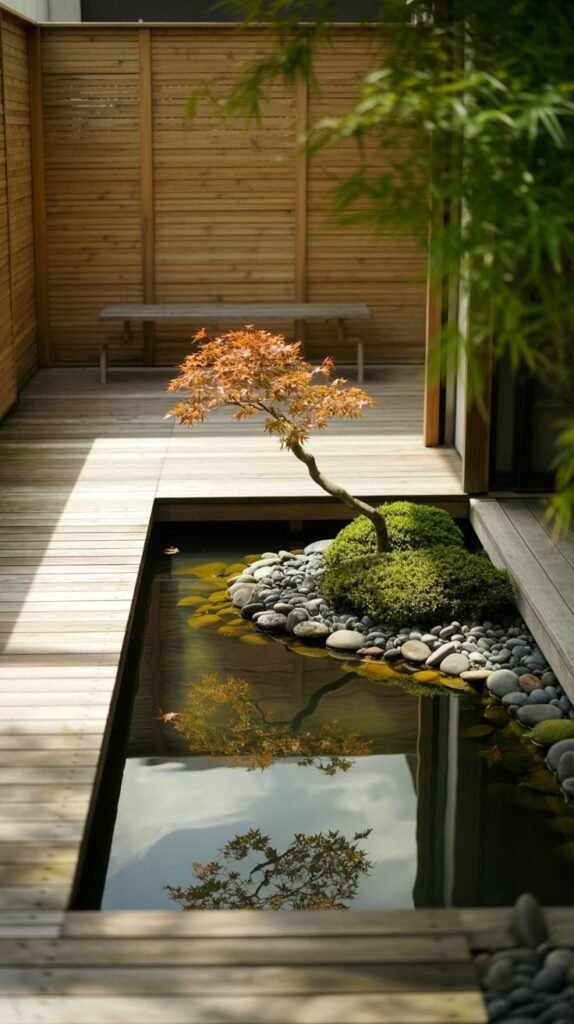
Create a truly harmonious minimalist garden experience by installing a long, narrow sunken pond. Design a small island within the pond, featuring a vibrant Japanese maple tree, allowing its seasonal colors to provide stunning reflections on the water’s surface. Edge the pond with smooth, dark pebbles and patches of moss, blending the water feature seamlessly with the surrounding landscape. Construct an expansive wooden deck that surrounds the pond on multiple sides, providing elevated views and comfortable seating. Allow the natural light to play across the water and the wooden surfaces, enhancing the tranquil and reflective qualities of the space.
21. Traditional Japandi Garden Path Leading to a Serene Gazebo
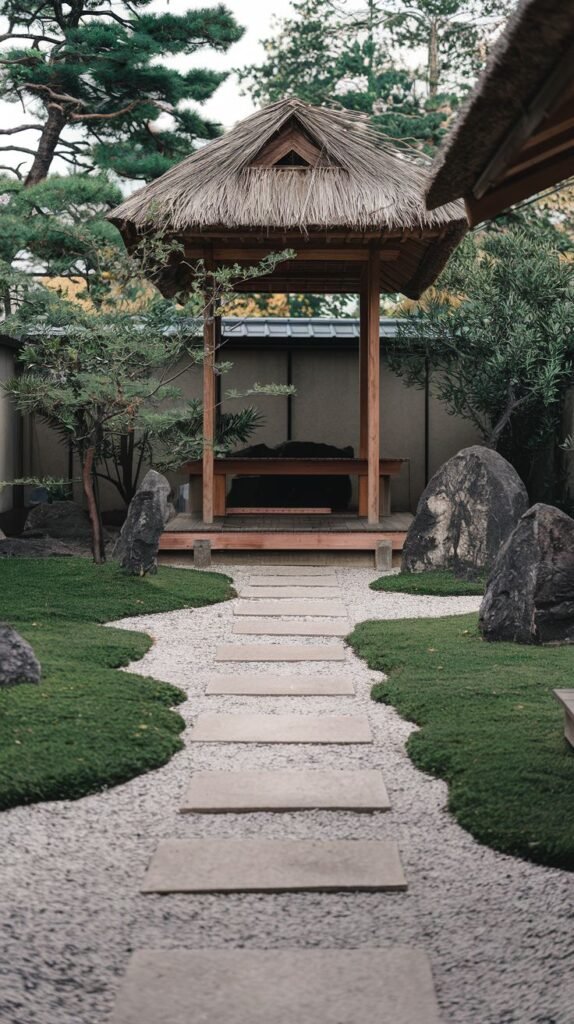
Establish a sense of journey in your Japandi garden by creating a winding path that leads to a peaceful destination. Lay a series of rectangular stepping stones through a combination of light gravel and soft green ground cover, guiding visitors gracefully through the landscape. Frame the path with large, naturally shaped rocks and scattered green plants, enhancing the organic feel. Conclude the path with a view or access to a traditional-style gazebo with a thatched roof, offering a sheltered space for quiet contemplation and enjoyment of the garden.
22. Classic Minimalist Zen Garden with Iconic Elements
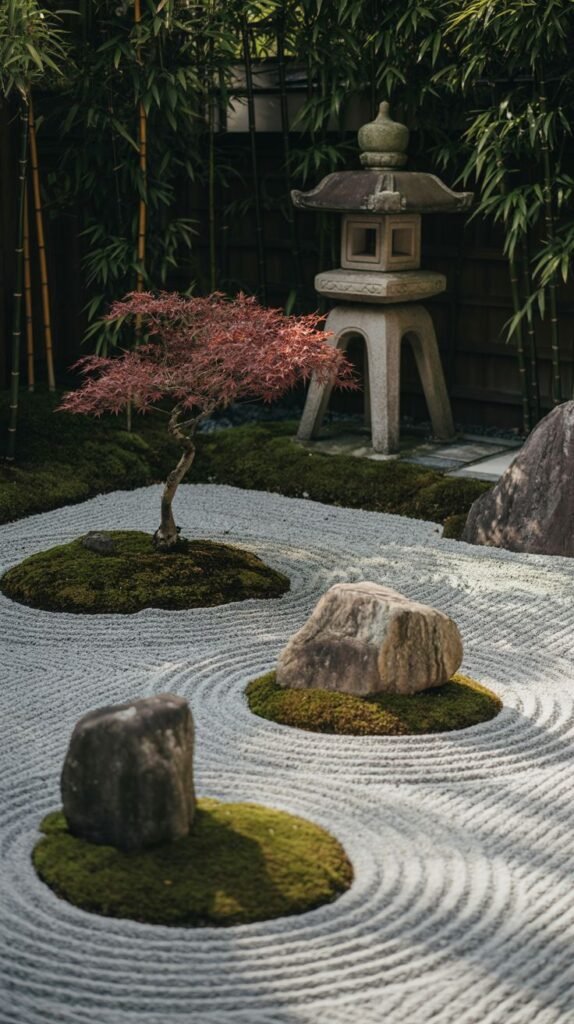
Design a quintessential minimalist Zen garden that incorporates iconic elements for meditation and aesthetic appreciation. Create a large bed of meticulously raked white sand, forming concentric circles and wave patterns that symbolize water. Feature a vibrant red Japanese maple tree planted on a small, moss-covered island, providing a striking splash of color and a focal point. Include additional moss-covered islands with natural rocks, symbolizing mountains or landmasses within the raked “sea”. Place a traditional stone lantern prominently within the garden, adding a timeless and spiritual element to the composition.
23. Modern Minimalist Zen Garden with Artistic Stone Arrangement
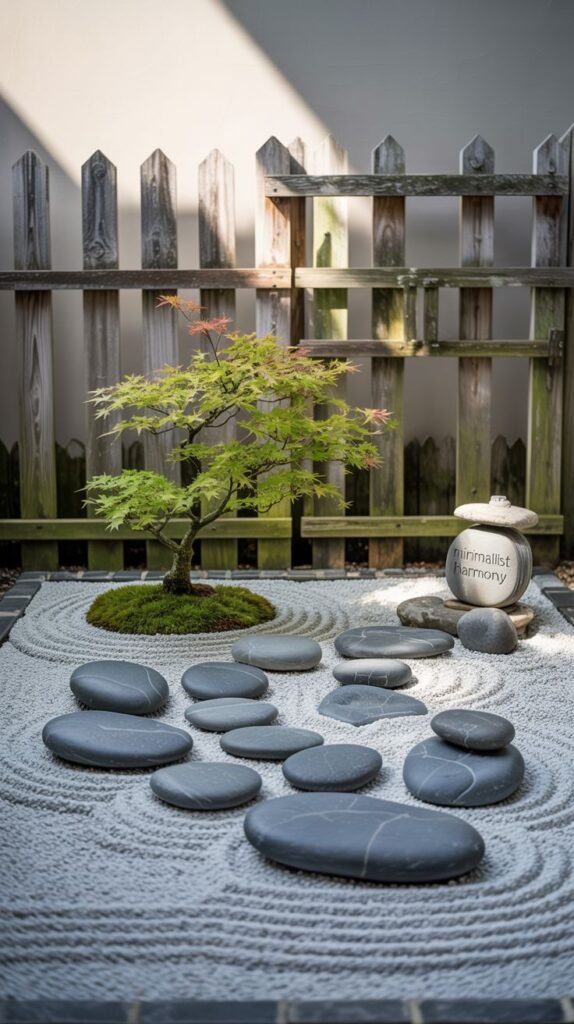
Develop a contemporary and artistic minimalist Zen garden focusing on the interplay of smooth stones and raked sand. Create a wide bed of finely raked light-colored sand, adorned with subtle, elegant patterns. Arrange a collection of large, smooth, flat grey stones of varying sizes to form an abstract pathway or sculptural grouping across the sand. Plant a small, young Japanese maple tree on a subtle moss mound, adding a touch of vibrant green and future growth. Use a rustic wooden fence as a natural backdrop, and add a small, decorative pot inscribed with “minimalist harmony” to subtly emphasize the garden’s core philosophy.
24. Compact Japandi Garden with Vertical Greenery and Water Cascade
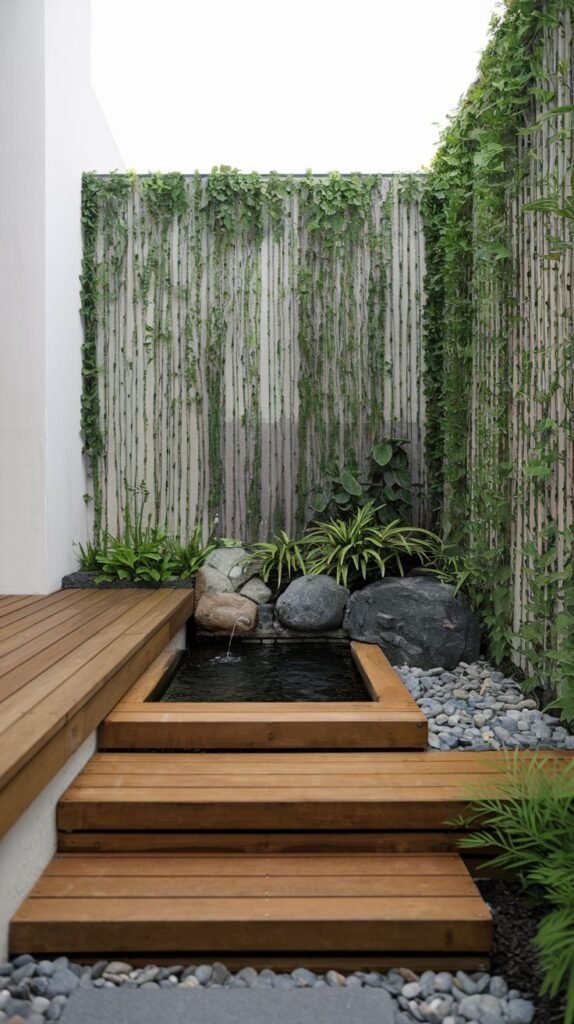
Maximize a compact space by designing an efficient and serene Japandi garden featuring both vertical greenery and a soothing water element. Install a narrow water feature with a gentle cascade, allowing the sound of trickling water to create a calming ambiance. Edge the water feature with smooth pebbles and lush, diverse plants, enhancing its natural appearance. Construct a multi-tiered wooden deck with steps leading down towards the water, providing both access and visual depth. Create a striking vertical element by covering a tall fence or wall with climbing plants or bamboo, bringing a lush green backdrop and privacy to the space.
